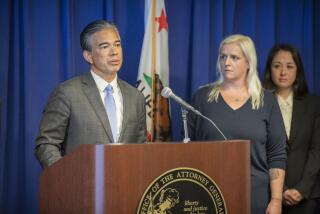The Politics of Heartbreak
- Share via
Claudia Crown Ades, Coreen Costello and Mary-Dorothy Line probably never would have met but for the tragedies that changed their lives forever.
Now, they’ve joined together to speak out against what they see as a tide of misperceptions and misinformation about intact dilation and extraction, a procedure they all underwent to end their late-term pregnancies because their fetuses had fatal birth defects and the mothers’ health was at risk.
“When you’re carrying a desperately wanted child, there’s nothing more in the world you want than that child,” said Ades, who underwent D&E; 3 1/2 years ago after tests in her sixth month of pregnancy showed that her fetus had severe abnormalities, including an underdeveloped brain, a large hole in his heart, eyes so far apart they were almost on the sides of his head, and a cyst on his chest filled with intestinal matter.
“It was not my decision,” Ades said. “It was God’s will.”
Better known by the graphic term that opponents have coined--partial-birth abortion--the medical procedure has become a central issue in the abortion debate in this election year. But for President Clinton’s veto, the practice would have been banned by a congressional bill except in cases when the mother’s life is at stake.
In emotional and sometimes shrill testimony in Congress legislators and witnesses supporting the bill portrayed the procedure as brutal and unnecessary. The bill, which was introduced by Rep. Charles T. Canady (R.-Fla.), described the method as “an abortion in which the person performing the abortion partially vaginally delivers a living fetus before killing the fetus and completing the delivery.”
Clinton said he had been inclined to support the bill but changed his mind after hearing the pleas of these three Los Angeles-area women and others, who convinced him he should not sign the legislation without a broader exception that recognizes the mother’s health, even if her life is not in immediate danger. Ades, Costello and Line were with the president when he vetoed the bill last month.
But these women say their fight is not over. Many states, including California, are considering similar legislation. Clinton’s veto is sure to draw fire as the November election draws near, and opponents continue to offer gruesome pictures and testimony in their campaign to outlaw the procedure. So, again and again, Ades, Costello and Line retell their wrenching tales in letters to legislators, at one-on-one meetings, and in editorials and tearful addresses.
*
They are a diverse group, but each woman could be a neighbor, a friend or a relative.
Ades, 37, is poised and sophisticated. She lives in Sherman Oaks and works in the entertainment industry as a personal manager. She is Jewish, a Democrat and supports abortion rights.
Costello, 31, is a warm, outgoing stay-at-home mother of two who lives in Agoura. A fundamentalist Christian and registered Republican, she opposes most legal abortions.
Line is a thoughtful, intensely private woman who works as a financial consultant. The 34-year-old Los Angeles resident, a registered Republican, is a practicing Catholic who nonetheless supports abortion rights.
All three endured a mother-to-be’s worst nightmare. At about their sixth month of pregnancy, they learned that their babies were so severely malformed that they would either die inside the womb or shortly after birth. Each underwent extensive testing and received opinions from several doctors. The news was always grim: Nothing could be done to save the babies, and as their conditions worsened, the risks to the mothers’ health and future fertility grew.
Through the recommendations of their doctors, all three ended up at the offices of Dr. James T. McMahon, a now-deceased Los Angeles physician who developed intact dilation and extraction.
“It’s a heartbreaking decision,” said Line, who underwent the procedure in July after her unborn son was found to have hydrocephalus. His head was filled with so much fluid that the brain could not grow, his stomach was undeveloped and he could not swallow.
“No one wants to do it,” she said. “We had no choice.”
Costello’s daughter also had a fluid-filled head that was larger at 6 months than a full-term baby’s. Her lungs had not developed, and her body was in a rigid swan-dive position, with the backs of her feet touching her head.
Costello remembers at one point, after learning early last year that her unborn daughter was dying, “praying like I’ve never prayed before. I begged God.” She and her husband, Jim, a chiropractor, at first refused to consider McMahon’s procedure.
But as Coreen’s health deteriorated, the Costellos were told by their doctor that they had to act. The excess amniotic fluid collecting in her uterus could have caused a rupture, and if the fetus died in utero, dangerous toxins could have been emitted.
The fetus had to come out, they were told, and the way to do it that would best protect Coreen’s fertility and cause the baby the least amount of suffering was an intact D&E.; A caesarean section was ruled out because the baby was given no chance of survival and because of possible complications.
*
As each woman came to grips with her loss, news reports began surfacing late last year about the so-called partial-birth abortion legislation. Each soon realized that the procedure in question was the one that they had undergone. Horrified over what they considered to be inaccurate and inflammatory arguments being put forth by the bill’s proponents, they individually decided to come forward. They became acquainted through their lobbying efforts, and today they are fast friends. They often coordinate speaking engagements and act as an informal support group for each other.
“These are the most incredible women I’ve ever had the pleasure of meeting and working with,” said Vicki Saporta, director of the National Abortion Federation, which opposed the bill. “It’s hard to ask people to share their most personal tragedies with Congress, Washington, the world. Some of them weren’t even over their own grieving process.”
Not all were moved by their testimony--at least not enough to change their positions. Costello admitted to being naive at first.
“I went up against people that I voted for, that I admired and respected my whole life,” she said. “I thought they’d read my letter, hear my story and it would be over. They’d understand.”
But after meeting with hostile questioning in the House, listening to others in Congress privately admit to political motives, and being avoided by legislators she sought out, Costello said she has changed. While she still opposes most legal abortions, “I’ve met women that have had to make difficult choices, and I don’t judge them anymore.”
The intact D&E;, or very similar procedures, are performed by just a handful of U.S. doctors in an estimated 500 cases a year.
McMahon’s widow, Gale, a registered nurse, said the general practitioner began performing abortions at his Los Angeles offices in 1972, after they became legal in California. But McMahon grew increasingly disturbed that most late-term abortions employed a dilation and evacuation method that sometimes tore the uterus, causing substantial blood loss, and involved dismembering the fetus.
With McMahon’s method, which he developed in the mid-1980s, the mother is heavily sedated and her cervix slowly dilated. The fetus is extracted, but before the head is removed a needle is inserted at the base of the skull to remove fluid, allowing the head to compress so it can fit through the mother’s cervix without damaging her. Gale McMahon said her husband never used scissors, as opponents have charged. The fetus feels no pain because of the sedation, she said, and in most cases it has died before reaching the birth canal.
Dr. McMahon estimated that he performed about 100 of the procedures a year in the third trimester, Gale McMahon said, and only in cases in which the babies were afflicted with “fetal anomalies that were not conducive to life.” The procedure is “the last resort of all the testing, all the doctors visits, all the discussions,” she said.
*
Opponents of the procedure, however, say the cases of Costello, Line and Ades do not represent the majority of instances when the method is used.
Douglas Johnson, legislative director for the National Right to Life Committee, contends that the procedure has been used for frivolous reasons, when babies are healthy and the only medical indications are the mother’s youth or depression. The procedures done on Ades, Costello and Line would have been allowed under the vetoed legislation, he said, if their lives had been at stake or if their babies had died in utero--since technically it’s not an abortion if the baby dies while still in the womb.
Johnson said there’s no proof that fetuses die painlessly during an intact D&E.; Even so, he said, the procedure is nothing more than “prenatal euthanasia.” The fetuses could be delivered, he said, and made “comfortable for whatever time is allotted them. That’s the way most professionals handle these types of cases.”
By including an exception for the mother’s health, the legislation could be so broadly interpreted that it “would not prevent a single partial-birth abortion.”
*
But Ades, Line and Costello say they’ll continue working to keep the procedure available to the few women a year who find themselves faced with tragedies similar to theirs. Perhaps the most compelling argument they offer is that all will soon be parents again--something they say might not have been possible if they hadn’t gone to McMahon.
Line and her husband, Bill, a consulting engineer, are expecting in September. Ades and her movie producer husband, Richard, are adopting a baby girl in July.
Costello is eight months pregnant. Her swollen belly could have hardly escaped notice when she testified before the House Judiciary Committee last month and told the members:
“When you vote on this bill again, please remember me. Remember my face, remember my name, remember my family and the child I am carrying.”
More to Read
Get the L.A. Times Politics newsletter
Deeply reported insights into legislation, politics and policy from Sacramento, Washington and beyond. In your inbox twice per week.
You may occasionally receive promotional content from the Los Angeles Times.










